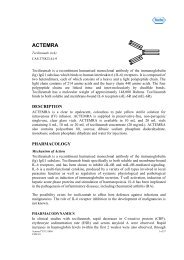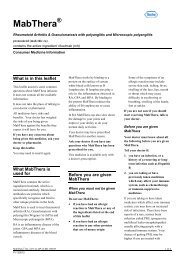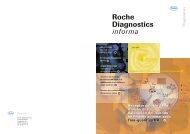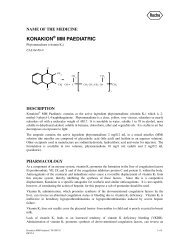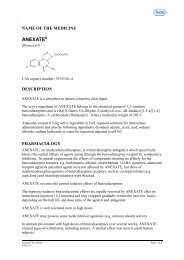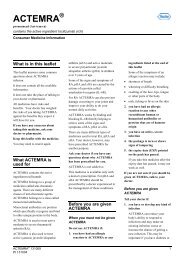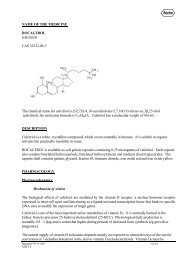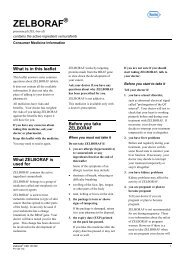Kredex (carvedilol) - Product Information (PI) - Roche Australia
Kredex (carvedilol) - Product Information (PI) - Roche Australia
Kredex (carvedilol) - Product Information (PI) - Roche Australia
You also want an ePaper? Increase the reach of your titles
YUMPU automatically turns print PDFs into web optimized ePapers that Google loves.
Bradycardia: In clinical trials, KREDEX caused bradycardia in about 2% of hypertensive patients<br />
and 9% of congestive heart failure patients. If pulse rate drops below 55 beats/minute, the dosage<br />
should be reduced.<br />
Hypotension: Hypotension and postural hypotension occurred in 9.7% and syncope in 3.4% of<br />
congestive heart failure patients receiving KREDEX compared to 3.6% and 2.5% of placebo<br />
patients, respectively. The risk for these events was highest during the first 30 days of dosing,<br />
corresponding to the up-titration period and was a cause for discontinuation of therapy in 0.7% of<br />
KREDEX patients, compared to 0.4% of placebo patients.<br />
To decrease the likelihood of syncope or excessive hypotension, treatment should be initiated with<br />
3.125 mg b.i.d. for congestive heart failure patients. Dosage should then be increased slowly,<br />
according to recommendations in the DOSAGE AND ADMINISTRATION section, and the drug<br />
should be taken with food. During initiation of therapy, the patient should be cautioned to avoid<br />
situations such as driving or hazardous tasks, where injury could result should syncope occur.<br />
Labile Hypertension: KREDEX should be used with caution in patients with labile or<br />
secondary hypertension until further clinical experience is available.<br />
Peripheral Vascular Disease: Beta-blockers can precipitate or aggravate symptoms of arterial<br />
insufficiency in patients with peripheral vascular disease. Caution should be exercised in such<br />
individuals.<br />
Raynaud's phenomenon: KREDEX should be used with caution in patients suffering from<br />
peripheral circulatory disorders (eg Raynaud's phenomenon) as there may be exacerbation of<br />
symptoms.<br />
Hypertensive Patients with Left Ventricular Failure: In hypertensive patients who have<br />
congestive heart failure controlled with digitalis, diuretics and/or an angiotensin-converting enzyme<br />
inhibitor, KREDEX (<strong>carvedilol</strong>) may be used. However, since it is likely that such patients are<br />
dependent, in part, on sympathetic stimulation for circulatory support, it is recommended that<br />
dosing follow the instructions for patients with congestive heart failure.<br />
Psoriasis: Patients with a history of psoriasis associated with β-blocker therapy should take<br />
KREDEX only after consideration of the risk-benefit ratio.<br />
Concomitant use of calcium channel blockers: Careful monitoring of ECG and blood pressure is<br />
necessary in patients receiving concomitant therapy with calcium channel blockers of the verapamil<br />
or diltiazem type or other antiarrhythmic drugs (see Drug Interactions)<br />
Hepatic Injury: Mild hepatocellular injury, confirmed by rechallenge, has occurred rarely with<br />
KREDEX therapy.<br />
In controlled studies of congestive heart failure, the incidence of liver function abnormalities<br />
reported as adverse experiences was 5.0% (38 0f 765 patients) in patients receiving KREDEX and<br />
<strong>Kredex</strong> ® <strong>PI</strong> 110720<br />
CDS 5.0 10 of 24



